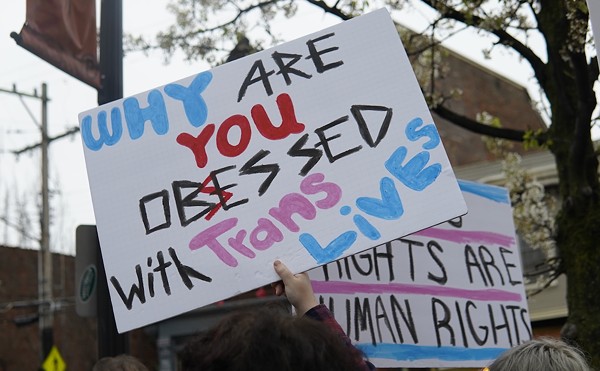S
quaring off with Ohio’s $8 billion deficit, Gov. John Kasich unveiled his first budget plan March 15 that pleased supporters of tax breaks for the wealthy while causing deep concern for librarians, among many others.
After a few shout-outs to his compadres in the town-hall style State of the State Address, Kasich thanked the lord for his blessings and got down to business, pegging joblessness as “the enemy” in Ohio. In passing, he revealed his plan to alleviate the budget hole by delivering a few tactical hooks and jabs to the budgets of select state agencies.
As expected, Kasich’s executive budget for fiscal year 2012-13 includes a proposal to further reduce state funding for the 251 public libraries in Ohio. The reductions total 5 percent, resulting in the loss of an additional $1.9 million dollars in annual funding for The Public Library of Cincinnati and Hamilton County alone.
“This 5 percent cut is on top of a 30 percent reduction in state funding since 2000,” says Amy Banister, marketing and programming manager for the local library system. “We have already reduced hours, cut staffing, frozen salaries, reorganized the Main library, postponed or cancelled capital improvements and doubled overdue fines.”
During the same decade, demand for library services has grown more than 23 percent. According to Banister, there are 364,904 active cardholders as of March 31, making it increasingly difficult to maintain all services.
Since 2001, the library has been forced to reduce staff by 20 percent and hours by 10 percent.
The reorganization of the Main Library in 2007 saved $1 million annually, yet more staff cuts are likely to occur despite Kasich’s proclaimed mission to create more jobs.
Kasich stated, “We’re going to have to reduce spending. If we can control our spending and begin to innovate, as we have started, this will allow us to create a platform for economic growth.”
Last year state funding represented 61.4 percent of all revenue received by The Public library of Cincinnati and Hamilton County. The Public Library Fund, funded with 1.97 percent of the total tax revenue received by the state of Ohio and divided among all public libraries in the state, remains the primary source of funding.
Fortunately, the library received the first year of revenue from the local tax levy approved overwhelmingly by Hamilton County voters in November 2009, amounting to $19.7 million (33 percent) of last year’s budget.
The remaining revenue came from fines and fees (3.3 percent), miscellaneous income such as refunds and shopping-bag sales (1.3 percent), contributions and gifts (0.4 percent), restricted grants (0.3 percent) and earnings on investments (0.2 percent).
Operating under these financial constraints, the library devotes the majority of its budget to salaries and benefits (63.9 percent), which dwarves all other expenses including library materials (14.9 percent), purchased and contracted services (14.2 percent), supplies (3 percent), capital improvements (2.2 percent) and furniture (1.9 percent).
“Since staffing costs are the largest line item in our budget, it is impossible to make up another 5 percent reduction in funding without reducing our workforce,” Banister says. “We will do everything possible to make that reduction through the elimination of vacant positions.”
Other prospective solutions include seeking out additional partnerships and collaborations with government agencies, nonprofits, media outlets and area businesses, along with the potential for raising overdue fines and merging branches.
No mergers are planned as of now, Banister adds.
To put library spending into perspective, $3.7 million was spent to buy books in 2010. New computer equipment was installed at 17 branch libraries using funds from the Bill and Melinda Gates Foundation. Also, donations were used to upgrade public computers at the 23 other branch libraries.
Some noteworthy gift funds include $1 million acquired from the Joseph S. Stern, Jr. Family Fund and Michael Dever’s donation of Parkview Manor, located on the corner of Jefferson and Brookline Avenues in Clifton’s Gaslight District. Built in 1895, Parkview Manor is a stone building with a prominent three-story turret in the Renaissance Revival style, formerly home to political boss George B. Cox. This acquisition provides an opportunity to relocate the Clifton Branch library to a larger facility in order to accommodate the increasing demand for library services in the neighborhood.
With a collection of roughly 9.2 million items, the library is among the top 10 U.S. library systems based on collection size. Circulation of more than 16.3 million items ranked it as the 10th busiest system in the nation.
Nevertheless, Ohio faces the end of billions of dollars in federal stimulus and other one-time monies, making statewide budget cuts a necessary measure not only for public libraries but also for local governments and schools, according to Kasich.
“The governor recognizes the important role libraries play in our communities and the 5 percent cut to library funding is not a reflection on their merits,” says Connie Wehrkamp, Kasich’s deputy press secretary. “It’s simply reality that our state is facing an $8 billion budget hole, and raising taxes to fill this hole would just drive more jobs out of our state.”
Kasich’s plan is designed to create jobs by adding more than $34 million in tax incentives intended to boost investments and entrepreneurship statewide.
During his speech, the governor stated, “We cannot tax our way to prosperity … we will not be raising taxes in this state.”
Neither the House nor Senate has passed the bill. By law, a new budget must be adopted by June 30. It will become effective July 1.
Despite a vague sense of impending doom, Banister has an optimistic outlook on the long-term future for public libraries in Ohio.
“With state tax revenues beginning to grow and library use rising, we expect library funding to begin to recover after this biennium,” she says. “Of course, we could be wrong.”





